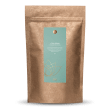Lemon Balm
Melissa officinalis is a southern European plant. Like many herbs from the south, it was first cultivated in monastery gardens and then gradually spread throughout Europe. The perennial plant sprouts in March and can grow up to 70cm tall by July and is clearly recognisable by its scent. Due to its many uses, however, it was cultivated early on throughout Europe as a popular aromatic herb. In the Middle Ages, it was cultivated in every monastery garden because it was considered particularly valuable.
Honeybush
Sweet honeybush, like rooibos, is a type of fynbos native to the cape region of South Africa. To produce honeybush tea, the bushy branches are cut close to the ground and hand-picked. After harvesting, the fresh branches are quickly brought in for processing to prevent oxidation and fermentation. The branches are gently fan dried at temperatures ranging from 99-115°C depending on the day temperature.
Sage
Sage (Salvia officinalis) belongs to the labiates family. It is found all over the world, except in Antarctica and Australia, and is one of the most diverse genera of angiospermous plants. Valued as a medicinal plant since ancient times, sage is an indispensable component of modern cuisine and medicinal herbs.
Camomile
Camomile (Matricaria chamomilla L.) is one of the best-known European herbs and has been an integral part of European herbalism for centuries. Camomile has conquered the entire planet alongside humankind, reaching as far as to the African continent. Camomile flowers contain a valuable combination of diverse botanicals, which are used in manifold ways.
Hyssop
Hyssop (Hyssopus officinalis) is a perennial plant of the Lamiaceae family. Its bright blue-violet flowers bloom between June and September, and are particularly attractive to bees. The plant belongs to the genus Hyssopus officinalis, whose five subspecies are native to southern and eastern Europe, western Asia and northern Africa. Hyssop has been used as a spice and medicinal plant in Europe since the early Middle Ages. Hildegard von Bingen mentions hyssop as a remedy for various ailments, including breathing and stomach issues.
Galangal
Galangal (Alpinia officinarum) belongs to the ginger family and originates from Southeast Asia. The thickened underground rhizomes are characteristic, they harbour a pungent, aromatic flavour. In the 9th century, galangal reached Europe and from the 11th century it also found its place in the herbal books of various monasteries. Hildegard von Bingen dedicated an entire chapter to it in one of her writings.
Passionflower Herb
The passion flower (Passiflora incarnata), native to Central and South America, made its way from the Suptropics to the colder parts of Europe and came to Europe as an ornamental plant. Its 5 scars are venerated in the Christian faith as the 5 wounds of Christ. While the indigenous tribes of the Americas mainly used the roots, the Europeans discovered the soothing effect of the herb.
Pansies
The pansy (Viola tricolor) is can be found in many places such as, flowerbeds or roadsides. Widespread in most parts of Europe, it is only absent in the northernmost and southernmost parts of this continent. It is an annual and grows to a height of about twenty centimetres. It prefers meadows, roadsides and fallow land, and its flowering period is from May to September. Since ancient times, this little sister of the violet has been enshrined in plant lore and many legends have grown up around it.
Valerian
Valerian (Valeriana officinale) can be found in almost all of Europe. It grows on the banks of streams and ditches, marshes and at the edges of forests. It is a perennial that reemerges in the spring. With its rich plant substances, it has been used in many ways since ancient times. This is also reflected in its name: "valere" in Latins means "to be healthy".
















